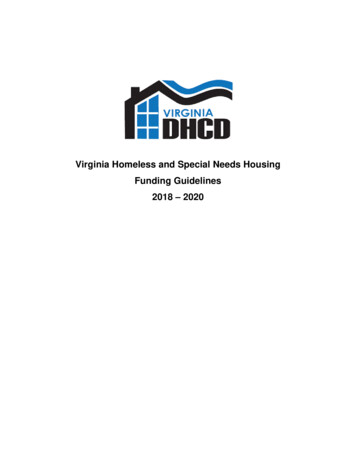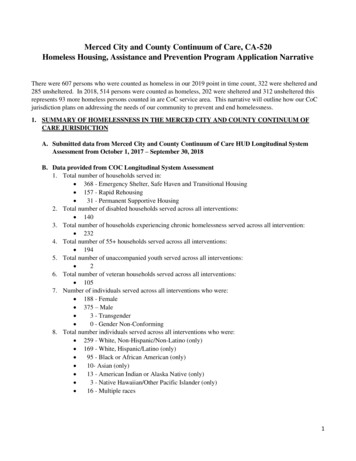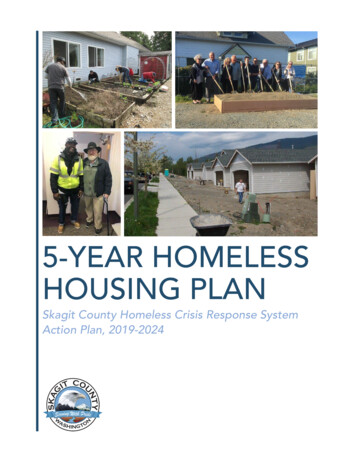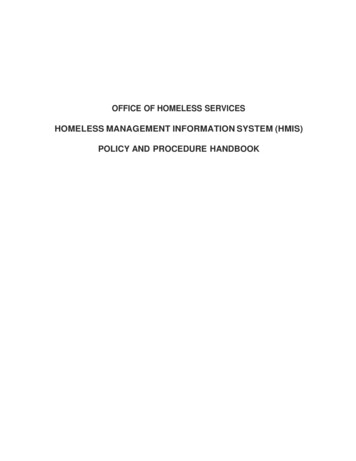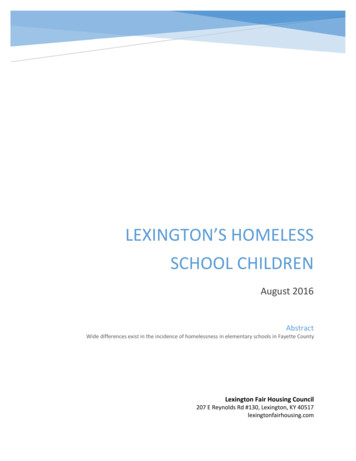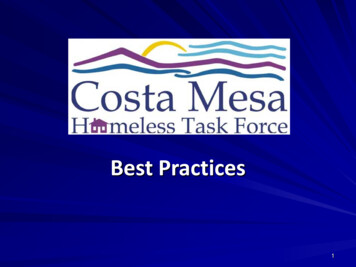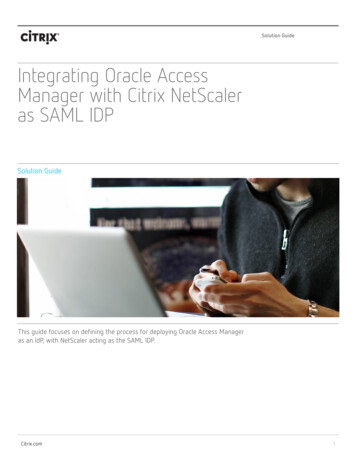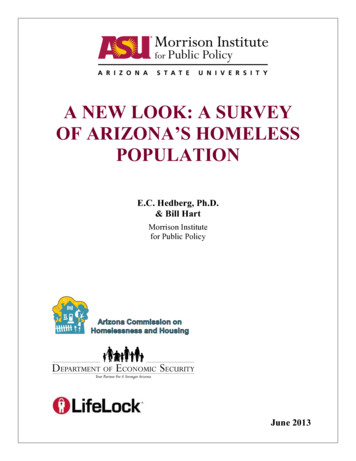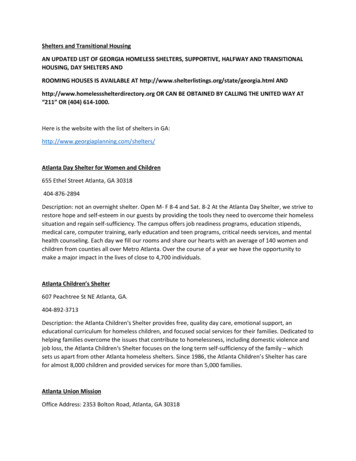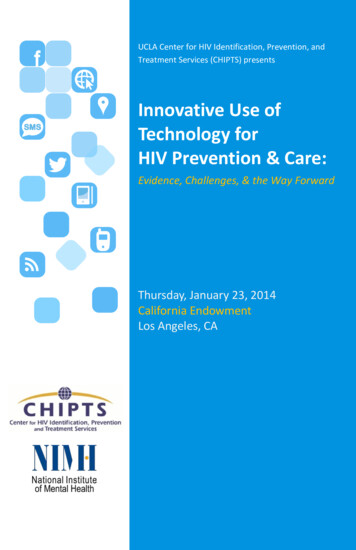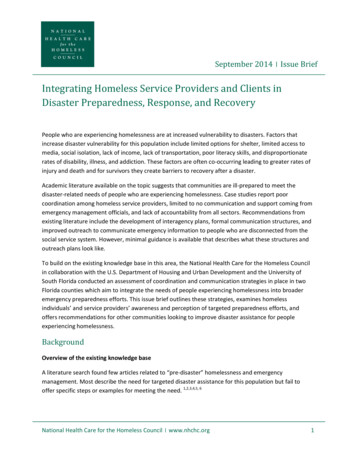
Transcription
NATIONALHEALTH CAREf OT th t'HOMELESSCOUNCILSeptember 2014 । Issue BriefIntegrating Homeless Service Providers and Clients inDisaster Preparedness, Response, and RecoveryPeople who are experiencing homelessness are at increased vulnerability to disasters. Factors thatincrease disaster vulnerability for this population include limited options for shelter, limited access tomedia, social isolation, lack of income, lack of transportation, poor literacy skills, and disproportionaterates of disability, illness, and addiction. These factors are often co-occurring leading to greater rates ofinjury and death and for survivors they create barriers to recovery after a disaster.Academic literature available on the topic suggests that communities are ill-prepared to meet thedisaster-related needs of people who are experiencing homelessness. Case studies report poorcoordination among homeless service providers, limited to no communication and support coming fromemergency management officials, and lack of accountability from all sectors. Recommendations fromexisting literature include the development of interagency plans, formal communication structures, andimproved outreach to communicate emergency information to people who are disconnected from thesocial service system. However, minimal guidance is available that describes what these structures andoutreach plans look like.To build on the existing knowledge base in this area, the National Health Care for the Homeless Councilin collaboration with the U.S. Department of Housing and Urban Development and the University ofSouth Florida conducted an assessment of coordination and communication strategies in place in twoFlorida counties which aim to integrate the needs of people experiencing homelessness into broaderemergency preparedness efforts. This issue brief outlines these strategies, examines homelessindividuals’ and service providers’ awareness and perception of targeted preparedness efforts, andoffers recommendations for other communities looking to improve disaster assistance for peopleexperiencing homelessness.BackgroundOverview of the existing knowledge baseA literature search found few articles related to “pre-disaster” homelessness and emergencymanagement. Most describe the need for targeted disaster assistance for this population but fail tooffer specific steps or examples for meeting the need. 1,2,3,4,5, 6National Health Care for the Homeless Council । www.nhchc.org1
Fullerton et al. (2009) interviewed 151 homeless individuals living in Washington, D.C. one-year after asniper killed 10 and wounded 4 individuals, all of whom were targeted by the sniper because they lackedhousing. The study focused on individuals using the shelter system, thus excluding more isolated anddisconnected individuals. Not surprisingly, the individuals participating in the study were found to bewell-connected to system supports subsequent to the terrorist attack; the extent of the support is notdescribed but is implied to be in the form of therapeutic support rather than tangible support such astransportation or housing. Fullerton, et al found that after the attack, 65% of the subjects restrictedtheir activities in order to protect themselves. This is important to note given the implications foroutreach services. Recommendations focused on the need for more research documenting effectiveoutreach strategies, communications from trusted and familiar sources which are shown to modifybehavioral responses, and planning among service providers for increased substance use and resultingwithdrawal and for medical care needs.7Leung, Ho, Kiss, Gundlapalli, and Hwang (2008) interviewed 19 key informants to identify issues relatedto homelessness that emerged during a 2003 SARS outbreak in Toronto. Nearly all homeless serviceproviders identified communication as a major challenge. Service providers claimed to have receivedinadequate information and few formal directives from public health officials. In addition, serviceproviders were unaware that one shelter had been designated as a quarantine facility for people whowere without housing. Though health officials reported knowledge of SARS occurring within thehomeless population, they described the need to address more pressing concerns for infection controlin hospitals and international travel. Recommendations included a line of communication betweenpublic health and homeless service providers using a single point of contact in the homeless community,an email system to disseminate urgent health advisories to homeless service providers, a formal processfor making decisions around consolidating services at fewer sites, designated quarantine facilities forpeople who lack housing, and resource allocation for homeless individuals and for homeless serviceproviders.8Another study (Washington, 1998) analyzed strategic efforts to meet the primary health care needs ofhomeless and migrant individuals living in Iowa after unprecedented flooding. During the flood, socialservice agencies acted individually, duplicated resources, and were unaware of other agency roles andresponsibilities. Furthermore, agencies were distributing information independently with no consistencyin instructions. As such, individuals who were experiencing homelessness were receiving inaccurateinformation through word of mouth. Strategic efforts taken by the county to address lessons learnedincluded inclusion of homeless and migrant populations in county health department emergency plans,organized roles and responsibilities for agencies, an interagency disaster plan, and a process forcoordinating information.9An article based out of Tokyo (Wisner, 1998) makes the case for utilizing social data in order to integratemarginalized citizens, particularly people who are experiencing homelessness, into emergencymanagement plans. Like the previous studies mentioned, the author describes the unique circumstancesof people who are experiencing homelessness that make them more vulnerable to disasters. Thesevulnerabilities include lack of access to information, financial credit or services, and lack of resourcesNational Health Care for the Homeless Council । www.nhchc.org2
such as income assets and social support. The author notes the progress that developing nations havemade in incorporating socially differentiated approaches to risk and vulnerability into public policy andurges developed countries to do the same.10Disaster risk and homelessness in Hillsborough and Pinellas CountyThe Tampa Bay Area is prone to severe storms, hurricanes, flooding, extreme heat and extreme cold.Evacuation from the area may be a necessary response to storm surges, hurricanes and flooding. Thereare evacuation concerns related to population density in costal and low lying areas and limited access toroads and bridges. Pinellas County forms a peninsula with only three bridges connecting lower PinellasCounty to the mainland. With limited evacuation routes, careful planning and community preparednesswill be key to preventing harm and potential loss of life in this area. Indeed, based on 2010 modeling ofvarious evacuation levels, it could take between 13 and 41 hours to evacuate Pinellas County. Manyresidents of Pinellas County will travel through Hillsborough County during evacuation and some maystay in Hillsborough County depending on how far inland the event is expected to reach. As such,resources for sheltering and other assistance in Hillsborough could be overwhelmed.Florida has one of the highest rates of homelessness in the United States. According to the 2013 AnnualHomeless Report to Congress, 50% of individuals experiencing homelessness who were identified duringa Point-in-Time Count resided in 5 states: New York, California, Florida, Massachusetts, and Texas. Morethan half of the nation’s chronically homeless individuals lived in 3 states: California, Florida, and NewYork. Additionally, while the nation experienced a decline in family homelessness overall, Florida wasamong the list of states to experience an increase among this population.Figure 1: Highest rates of unsheltered homeless people by State, 2013StatelofHomeless PeopleI of UnshelteredHomeless People% of Homeless Peoplewho were Unsheltered136,82691,27266.7Highest RatesCalifornia47,86228,1 9258.9Arka nsas3,81 054.9FloridaSource: U.S Interagency Council on Homelessness, 2013 Annual Homeless Assessment Report to CongressNational Health Care for the Homeless Council । www.nhchc.org3
Figure 2: Highest rates of unsheltered people in families by State, 2013State# of Homeless% of Homeless PeopleIn Famlhes who wereUnshelteredI of UnshelteredPeople in FaminesPeople in FamiliesHighest RatesFl orida16,5039,163.5Oregon4,8281,99841.4South pi65021533.1Source: U.S Interagency Council on Homelessness, 2013 Annual Homeless Assessment Report to CongressFigure 3: Highest rates of unsheltered chronically homeless people by State, 2013State# of Chronically # of Unsheltered ChronicallyHomeless PeopleHomeless People% of Chronically Homelesswho were UnshelteredHighest 1,18090776.9Source: U.S Interagency Council on Homelessness, 2013 Annual Homeless Assessment Report to CongressFigure 4: Highest rates of unsheltered veterans by State, 2013# of Homeless Veterans# of UnshelteredHomeless 32458.13,1777a552.5StateHighest RatesCaliforniaFlorid a5,50Oregon1,49457.7Source: U.S Interagency Council on Homelessness, 2013 Annual Homeless Assessment Report to CongressCoordination and Communication Strategies in Pinellas and HillsboroughCountiesTo better understand the structures in place to assist people experiencing homelessness before, during,and after a natural disaster, interviews were conducted with 18 individuals in Pinellas and HillsboroughCounties. The individuals were identified by their local homeless coalitions and through snowballNational Health Care for the Homeless Council । www.nhchc.org4
sampling and were described as being a major stakeholder or having significant knowledge or expertisein emergency planning activities related to homeless populations in their jurisdiction. Based on theinterviews, we identified the primary strategies put in place in both counties to coordinate humanservice agencies and integrate the disaster needs of vulnerable populations, including peopleexperiencing homelessness. These strategies are described below.Pinellas CountyPinellas County uses a combination of strategies to help improve coordination and communicationacross sectors to better assist vulnerable populations during disaster. These include a planningcommittee (Recover Pinellas) made up of human service agencies, a database (SAMS Ready System)aimed to improve surveillance and movement of available resources, and sheltering/evacuationoperating procedures for the homeless service community.Recover PinellasPinellas County has an emergency managementagency that oversees and maintains a county-widedisaster preparedness and recovery plan. Theagency is a member of Recover Pinellas, a standalone network of agencies that facilitatescoordination and communication among public andprivate human service agencies during all phases ofa disaster. Recover Pinellas was established inFebruary 2014 when the Disaster RecoveryLeadership Network (DRLN) and Pinellas CountyOrganizations United in Disaster (PROUD) merged.Recover Pinellas is not integrated into the county’semergency plan but is considered a major partnerand holds a seat at the emergency operationscenter.,,As of June 2014, Recover Pinellas is in the process of drafting its by-laws. However, it will continue tomaintain the objectives of the former Disaster Recovery Leadership Network which is to help ensurethat health and human service organizations in Pinellas County are optimally prepared for any majordisaster, work with community partners to develop and implement plans that will ensure that PinellasCounty residents have access to health and human services during long-term recovery from a majordisaster, and facilitate coordination and communication among Network stakeholders during all phasesof a disaster.Recover Pinellas will use a communication plan that is likely to remain similar to the one laid out by theDisaster Recovery Leadership Network. The Communications Plan is designed to provide a frameworkand Standard Operating Guidelines (SOG) to guide health and human services response efforts inNational Health Care for the Homeless Council । www.nhchc.org5
Pinellas County, FL, after natural disasters and emergencies including, but not limited to, hurricanes,tornadoes, high winds, and flooding. The Communications Plan is intended to provide notification tothose responsible for executing the Plan when a disaster looms or has occurred, provide guidance forrestoring services, facilitate communication between participating agencies to manage service delivery,and provide needed short term assistance. The Communications Plan is organized in a structural format,starting with a brief background, a diagram showing the flow of communications, a review of theconcept of operations, and specific pre- and post-disaster operational activities. Where possible, theStandard Operating Guidelines augment operational guidelines to help add specificity to the manyprocesses, tasks and activities that must be completed prior to and after a disaster. TheCommunications Plan is intended to complement the Pinellas County Board of County CommissionersComprehensive Emergency Management Plan (CEMP). See Appendix A for the Communication FlowDiagram.SAMS Ready SystemCurrently, the primary mechanism for human service agencies to report the status of their organization,including whether or not they are operational, have resources to share, or are in need of resources isthrough 211. However, Pinellas County is currently developing the SAMS Ready System which aims tostreamline status reports from human service agencies. The purpose of the SAMS Ready System is toserve as a community data base of human service organizations status following a disaster. The database will be a warehouse of the agencies that will be accessed to move necessary resources throughoutPinellas County post disaster. The system can serve as a notification system through text or email toupdate users of status of the disaster and other pertinent information.Homeless Evacuation/Sheltering PlanPinellas County has a separate operating procedure for homeless evacuation and sheltering. Theoperating procedure describes the process and entities responsible for training and awareness,communication and notification, transportation, homeless support personnel for shelters andevacuation buses, and data collection. The operating procedure provides the homeless servicecommunity with specific and concrete list of deliverables, when they will be delivered, and how they willbe delivered. Additionally, the Pinellas County Homeless Evacuation/Sheltering Plan includes a specialneeds shelter designated for people experiencing homelessness. The shelter is an optional resource forpeople experiencing homelessness and is staffed with homeless support services. See Appendix B.Hillsborough CountyHillsborough County’s primary strategy for improving disaster preparedness, response, and recovery forvulnerable populations is the Vulnerable Populations Task Force which guides emergency managementactivities for a number of high risk populations including people experiencing homelessness.Additionally, HELP, Inc. provides resources and support for individuals and families who are ineligible formainstream recovery assistance or who may need additional support if other assistance programs areNational Health Care for the Homeless Council । www.nhchc.org6
insufficient for meeting needs. Because people experiencing homelessness often do not qualify forFEMA housing assistance, HELP, Inc. is included as core strategy to assist this population.Vulnerable Populations Task ForceHillsborough County’s emergency managementstrategy is outlined in the Hillsborough CountyComprehensive Emergency Management Plan. TheEmergency Support Function leads for ESF-6, 8, 11 and15 play key roles in coordinating health and humanservices before, during, and after a disaster. To bettermeet the needs of high risk populations, such aspeople experiencing homelessness, the HillsboroughCounty Office of Emergency Management holdsregular meetings of a Vulnerable Populations TaskForce.The Vulnerable Population Task Force identifiesstakeholders (or critical players) that will help the TaskForce meet goals related to communication andresource coordination to meet the needs of targetedpopulations including people experiencing homelessness. Their goals include identifying vulnerablepopulations, developing plans for reaching these populations, defining regional and local resources toextend their reach to these populations, and defining tasks for timely and appropriate communicationand coordination. The Task Force also developed a Continuity of Operations training program for criticalagencies serving these populations to enable them to resume their operations as quickly as possible inorder to continue providing regular services to their existing clients as well as others.The Tampa Hillsborough Homeless Initiative (THI) is a member of the Vulnerable Population Task Force.THI is the lead agency for HUD Continuum of Care funding as well as the Tampa/Hillsborough 10-yearplan to end homelessness. They take a lead role in bringing together organizations to discuss strategiesto prevent and end homelessness in Hillsborough County. In this role, they are often seen as a point ofcontact into the homeless community by other public and private sectors. Emergency managementactivities are regularly discussed in group meetings and THI facilitates community trainings andawareness of homeless evacuation and sheltering plans. See Appendix C.HELP, Inc.HELP, Inc. is a Long Term Recovery Organization and an independent 501(c)(3) coalition that coordinatesneed-based recovery initiatives for residents of Hillsborough County. HELP, Inc. has been written intothe County Comprehensive Emergency Management Plan as the entity responsible for restoringimpacted lives primarily, but not exclusively, by rebuilding and fortifying homes. HELP works to identifyall interested organizations whose participation will enhance long-term recovery. The long-termNational Health Care for the Homeless Council । www.nhchc.org7
recovery process includes identifying respective unmet needs of individuals and families within theimpacted area and assigning a case manager to facilitate the recovery process for them. Financing thatprocess is the responsibility of HELP, Inc. HELP, Inc. applies for grants through multiple resources andutilizes those funds as well as donations to fund recovery needs. Case managers are charged withunderstanding the sequence of delivery of private and federal disaster resources and maximum awardsavailable as well as where additional resources can be accessed through existing programs for whichclients may qualify. Case managers access up to date information about local programs providingdisaster assistance through HELP, Inc. which uses an information sharing database developed by theCoordinated Assistance Network (CAN).HELP funds are used as a source of last resort to meet any remaining unmet needs after all otherpotential resources have been exhausted. Because people experiencing homelessness often do notqualify for other public disaster assistance, HELP funds may be one of the few recovery resourcesavailable to meet the needs of this group, including residential needs.2-1-1 (Crisis Center of Tampa Bay)The Crisis Center of Tampa Bay is in the process of developing a database of that will offer a streamlinedapproach to identifying agencies that are providing services during and after an event, includinghomeless service agencies. The Crisis Center of Tampa Bay serves as the lead agency for ESF-15(Volunteers and Donations) and is charged with coordinating information for the database. The ESF-15lead and supporting agencies also ensure that human services agencies, including those involved inCommunity Organizations Active in Disaster (COAD) and HELP, Inc., are aware of donated goodsavailable at the county-operated donations warehouse.Homeless Individual and Service Provider Knowledge and Perceptions ofCoordination and Communication StrategiesMethodologyFaculty of the University of South Florida conducted a total of seven focus groups in order to assess theknowledge base and perceptions of emergency management efforts. Four focus groups consisted ofpeople experiencing homelessness; three focus groups were conducted with service providers. Thestudy was approved by the University of South Florida Institutional Review Board and followedestablished ethical guidelines. Semi-structured questions were used to guide conversation in the focusgroups. Audio-tapes from all focus groups were transcribed for content analysis. In addition, the tapeswere compared to transcribed notes taken during the focus group by two members of the researchteam. While many interesting topics were covered, extraneous stories were not included in the analysis.The homeless focus groups consisted of persons who had been or were currently homeless and had theexperience of living through a natural disaster. To recruit homeless persons in the two counties, theTampa Hillsboro Homeless Initiative (THI) and the Pinellas County Homeless Leadership Board (HLB)helped to disseminate information regarding this study, which enhanced local support. For the purposeNational Health Care for the Homeless Council । www.nhchc.org8
of this study, homeless individuals were defined as those who live on the street as well as those whowere staying in a shelter. All participants were over the age of 18 and English speaking. Small dollar giftcards to a major family chain store or eating establishment were provided to participants. Focus groupquestions centered on their disaster experiences. A total of 31 participants from four distinct focusgroups participated in this study.The service provider focus groups consisted of key government agency personnel, social serviceproviders for homeless individuals, and representatives of first responder organizations. To recruitpersons who are involved in the emergency response to natural disasters in the communities,individuals were identified by the position that they held in the county emergency management agency,position as a first responder, or by the position they hold in a social service organization which serveshomeless individuals or those at risk of homelessness; this included shelter settings. THI and HLB helpedto identify these organizations and personnel. Participants had to be English speaking and over 18 yearsof age. No compensation for their participation was offered to this group. Focus group questions for thisgroup centered on the processes and policies used to help those who are homeless during a naturaldisaster. A total of 15 service personnel participated in two distinct Pinellas County focus groups. A totalof 7 service personnel participated in one Hillsborough County focus group.FindingsHomeless focus groups Information travels through word of mouth. Respondents indicated that information is spread byword of mouth through informal street networks and tends to reach individuals living in isolatedwooded areas. Information often originates from individuals who own radios, have access totelevision, or by a trusted community homeless advocate. One participant said “we take care of ourown” implying proactive efforts to communicate information to others in the homeless community.However, respondents noted that information is generally limited to notification of an ensuingweather event; information about resources and assistance does not tend to travel through informalcommunication sharing. Information communicated by police officers may not be well received. Respondents were awareof efforts by the service community to get the news out to them, often by sending police officers outto known homeless encampments. However, this caused great concern among respondents. In thefirst group, the phrase “Send Red, not Blue” emerged. What this meant was that firefighters (thosewho wear red), were trusted much more than police officers (those who wear blue.). Other groupsshared this same sentiment. Participants noted previous encounters with police as the reason whythey “turn the other way” when they see police approaching. Police were described as “unhelpful,”“not caring,” and “not informed” about their needs during pre-disaster periods. Respondents generally knew how to protect themselves from harm. As respondents shared theirstories, common survival tactics began to emerge. Responses included: “Get to higher ground”,“find a parking garage” (a strong foundation to withstand the winds and rain), “find an abandonedNational Health Care for the Homeless Council । www.nhchc.org9
house or bridge”, “seek shelter”, “hook up with people who are housed”, or “leave.” For those whodecided to wait out the storm, efforts were made to acquire additional supplies for protecting theirsleeping area and belongings, including trying to keep important documents as dry as possible. Timing of notifications is important and warrants special consideration. One respondent said,“What you consider to be a natural disaster while living in a house is completely different than whatwe consider to be a disaster while living in the woods.” What he meant by this, which was agreedupon by others, was that by the time local officials declared an emergency or started evacuationprocedures, those on the street were already experiencing the impact of the tropical storm. The decision to use shelter facilities is based on past experience. Past experiences with shelterservices influence the decision to use this option during the time of a natural disaster. Rules or“prison mentality,” stares from other occupants in the shelter, the feeling of being “looked downupon,” insensitive staff, and the stories from the Hurricane Katrina and the Superdome were justsome of the reasons given for not wanting to use shelter services during a natural disaster.Alternatively, homeless respondents preferred to seek refuge with a friend or stranger, at a motel,or leave the area typically before a full evacuation order. Some individuals said that they preferred ahomeless specific emergency shelter in order to avoid the stigma from their housed counterparts.Shelter services, however, were seen as a viable option for women, children, and those who neededspecial assistance. Some anticipated neglect as the needs of people with housing are prioritized. As one individualindicated, “the government (meaning first responders) will hold back getting regular people—whywould they come out for me?” Another stated “The homeless would be last to be helped. We wouldbe at the end of the list.” This sentiment may be a response to feelings of stigma or perceptions ofdisaster response after the experiences of individuals who were impacted by Hurricane Katrina. People on the street help one another but need additional information on how to help those whoneed special assistance. Respondents expressed concern for those on the street who were morechallenged. Respondents indicated that many in the homeless community knew who would needadditional help. It was suggested that those who need special assistance can be helped by others onthe street to get safely to first responders or shelters. Again, this reflects the sentiment, “we takecare of our own,” and the feeling that shelters are a viable option for people who have higher needs. Assistance from organizations that was passed up prior to an event may be welcomed duringreconstruction. Immediate actions for those without shelter include an assessment of lostbelongings including identification papers, medications, clothes, sleeping supplies, and general livingitems. Attention to bodily harm and health tends to be secondary. At this time, assistance fromorganizations like the Salvation Army and the Red Cross to meet immediate needs are welcomed. Reconstruction can be an opportunity to connect people to work. Many of the homelessrespondents saw the post-disaster environment as an opportunity to find work. Hauling branches,helping local homeowners and businesses clear and clean up properties was identified by this groupNational Health Care for the Homeless Council । www.nhchc.org10
as an opportunity to earn income to help replenish needed supplies. However, they noted that theyare typically not connected to work opportunities after an emergency and questioned the logic forthis.Service Provider Focus Groups Service providers offered a different perspective on their attention to the homeless populationthan the homeless focus groups. In areas where there was a known high concentration of streetand wooded homeless, coordinated efforts to inform homeless individuals about approachingstorms began early; up-to three weeks prior to an event in one county. Information is distributed tohomeless service providers and in areas with high concentrations of homelessness and searches ofabandoned buildings and shelters begins. In addition, police are dispatched, as are othercommunity volunteers depending on the area in either county, to notify those without shelter. Linkages to the local emergency management agency impacts service provider understanding andparticipation in disaster efforts. Professionals who worked for agencies associated with disasterservices, not surprisingly, had detailed information about the chain of comm
Coordination and Communication Strategies in Pinellas and Hillsborough Counties . To better understand the structures in place to assist people experiencing homelessness before, during, and after a natural disaster, interviews were conducted with 18 individuals in Pinellas and Hillsborough Counties.
